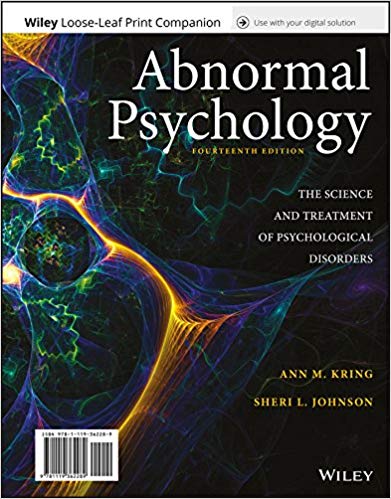Description
Test Bank for Abnormal Psychology, 14th Edition By Ann M. Kring, Sheri L. Johnson
Package Title: Chapter 2, Testbank
Course Title: Kring, Abnormal Psych 14e
Chapter Number: 2
Question Type: Multiple Choice
1. What is the best way to describe current thinking about psychopathology?
a) It is multifaceted.
b) It is a mental disease.
c) It all can be cured.
d) Drug Therapy is the best way to treat all disorders.
Answer: a
Section Reference: The Genetic Paradigm
Difficulty: Easy
Learning Objective: Describe the essentials of the genetic, neuroscience, and cognitive behavioral paradigms.
Bloomcode: Knowledge
2. A set of basic assumptions that defines how to conceptualize and study a subject, how to gather and interpret relevant data, even how to think about a particular subject is known as a ________________.
a) theoretical perspective.
b) hypothetical stance.
c) paradigm.
d) none of the above.
Answer: c
Section Reference: The Genetic Paradigm
Difficulty: Easy
Learning Objective: Describe the essentials of the genetic, neuroscience, and cognitive behavioral paradigms.
Bloomcode: Knowledge
3. Paradigms in the study of psychopathology
a) increase objectivity.
b) slow innovation.
c) increase confidence in our conclusions regarding mental illness.
d) enable us to gather knowledge in a systematic manner.
Answer: d
Section Reference: The Genetic Paradigm
Difficulty: Medium
Learning Objective: Describe the essentials of the genetic, neuroscience, and cognitive behavioral paradigms.
Bloomcode: Analysis
4. When a scientist chooses a paradigm to understand psychopathology, it
a) has little effect on clinical practice.
b) leads to an overly narrow perspective.
c) is generally too narrow in focus.
d) specifies which problems they will investigate and how they will go about investigating them.
Answer: d
Section Reference: The Genetic Paradigm
Difficulty: Easy
Learning Objective: Describe the essentials of the genetic, neuroscience, and cognitive behavioral paradigms.
Bloomcode: Knowledge
5. Contemporary views on genetic and environmental factors in behavior emphasize that
a) genes are important for only some behaviors.
b) a good environment can overcome genetic limitations.
c) both factors influence each other.
d) the percentage of genetic influence on a behavior can be measured.
Answer: c
Section Reference: The Genetic Paradigm
Difficulty: Medium
Learning Objective: Describe the essentials of the genetic, neuroscience, and cognitive behavioral paradigms.
Bloomcode: Analysis
6. The carriers of the genetic information passed from parent to child are called
a) nature.
b) genes.
c) zygotes.
d) DNA.
Answer: b
Section Reference: The Genetic Paradigm
Difficulty: Easy
Learning Objective: Describe the essentials of the genetic, neuroscience, and cognitive behavioral paradigms.
Bloomcode: Knowledge
7. What makes us unique is the
a) number of genes we have.
b) the amount of DNA we inherit.
c) the number of genes we inherit.
d) the sequencing of our genes.
Answer: d
Section Reference: The Genetic Paradigm
Difficulty: Easy
Learning Objective: Describe the essentials of the genetic, neuroscience, and cognitive behavioral paradigms.
Bloomcode: Knowledge
8. The switching on and off of certain genes is called
a) gene expression
b) gene sequencing
c) DNA ordering
d) DNA display
Answer: a
Section Reference: The Genetic Paradigm
Difficulty: Easy
Learning Objective: Describe the essentials of the genetic, neuroscience, and cognitive behavioral paradigms.
Bloomcode: Knowledge
9. When discussing heritability, it is important to keep in mind all of the following EXCEPT:
a) heritability estimates range from 0.0 to 1.0.
b) the higher the heritability value, the greater the heritability.
c) heritability is relevant for a particular individual.
d) heritability is relevant for large populations.
Answer: c
Section Reference: The Genetic Paradigm
Difficulty: Medium
Learning Objective: Describe the essentials of the genetic, neuroscience, and cognitive behavioral paradigms.
Bloomcode: Analysis
10. According to behavior genetics research,
a) nonshared experiences have much more to do with mental illness than shared experiences.
b) shared experiences have much more to do with mental illness than nonshared experiences.
c) shared and nonshared experiences are equally important for mental illness.
d) there is no way to differentiate between shared and nonshared contributions to mental illness.
Answer: a
Section Reference: The Genetic Paradigm
Difficulty: Medium
Learning Objective: Describe the essentials of the genetic, neuroscience, and cognitive behavioral paradigms.
Bloomcode: Analysis
11. Psychopathology is polygenic, meaning that
a) there are several different paradigms to explain abnormal behavior.
b) there are several different genes operating at different times during development that influence vulnerability.
c) the human genome consists of around 30,000 genes.
d) if a person had a gene for a given disorder, he or she would most likely get that disorder.
Answer: b
Section Reference: The Genetic Paradigm
Difficulty: Easy
Learning Objective: Describe the essentials of the genetic, neuroscience, and cognitive behavioral paradigms.
Bloomcode: Knowledge
12. If the heritability of ADHD is around .70, then
a) 70% of ADHD is due to .environment and 30% is attributed to genes.
b) 30% of ADHD is due to genes and 70% is attributed to variations in our brain.
c) individual heritability for ADHD is .70 and has little to do with our parents.
d) In a given population, approximately 70% of variation in ADHD is attributed to genes and approximately 30% is attributed to the environment.
Answer: d
Section Reference: The Genetic Paradigm
Difficulty: Medium
Learning Objective: Describe the essentials of the genetic, neuroscience, and cognitive behavioral paradigms.
Bloomcode: Application
13. Which of the following statements is false?
a) Heritability is a population statistic ranging from 0.0 to 1.0.
b) Heritability is the extent to which variability in a particular behavior in a population can be accounted for by environmental factors.
c) Heritability is a measure of what varies in a population.
d) The higher the heritability statistic, the more a particular behavior can be accounted for by genetic factors.
Answer: b
Section Reference: The Genetic Paradigm
Difficulty: Medium
Learning Objective: Describe the essentials of the genetic, neuroscience, and cognitive behavioral paradigms.
Bloomcode: Analysis
14. Research suggests that
a) shared environmental factors is what matters most for understanding genetic variability among siblings.
b) heritability is what determines a behavior in a population.
c) the effect of nonshared environmental events on siblings is what matters most for understanding genetic variability among siblings.
d) specific types of events determine genetic variability among siblings.
Answer: c
Section Reference: The Genetic Paradigm
Difficulty: Medium
Learning Objective: Describe the essentials of the genetic, neuroscience, and cognitive behavioral paradigms.
Bloomcode: Analysis
15. One’s inherited genes are referred to as
a) phenotypes.
b) genotypes.
c) somatotypes.
d) allele types.
Answer: b
Section Reference: The Genetic Paradigm
Difficulty: Easy
Learning Objective: Describe the essentials of the genetic, neuroscience, and cognitive behavioral paradigms.
Bloomcode: Knowledge
16. One’s observable characteristics are called
a) fistulas.
b) genotypes.
c) genetic types.
d) phenotypes.
Answer: d
Section Reference: The Genetic Paradigm
Difficulty: Easy
Learning Objective: Describe the essentials of the genetic, neuroscience, and cognitive behavioral paradigms.
Bloomcode: Knowledge
17. A genotype is illustrated by which of the following?
a) Kim’s eye color
b) Kim’s hair color
c) Kim’s unexpressed gene for sickle cell
d) Kim’s two recessive genes
Answer: c
Section Reference: The Genetic Paradigm
Difficulty: Medium
Learning Objective: Describe the essentials of the genetic, neuroscience, and cognitive behavioral paradigms
Bloomcode: Application
18. A phenotype is illustrated by which of the following?
a) Lisa’s mom’s weight.
b) Lisa’s chromosomes.
c) Lisa’s eye color.
d) Lisa’s DNA structure.
Answer: c
Section Reference: The Genetic Paradigm
Difficulty: Medium
Learning Objective: Describe the essentials of the genetic, neuroscience, and cognitive behavioral paradigms.
Bloomcode: Application
19. The behavior genetic view suggests which of the following relationships between genes and abnormal behavior?
a) Genetic predispositions increase the likelihood of abnormal behavior.
b) It is possible and reasonable to manipulate an individual’s genes.
c) Twins are more likely to exhibit abnormal behavior.
d) None of the above.
Answer: a
Section Reference: The Genetic Paradigm
Difficulty: Easy
Learning Objective: Describe the essentials of the genetic, neuroscience, and cognitive behavioral paradigms.
Bloomcode: Knowledge
20. Any measure of intelligence is best viewed as an index of
a) genotype.
b) phenotype.
c) shared environment.
d) nonshared environment.
Answer: b
Section Reference: The Genetic Paradigm
Difficulty: Medium
Learning Objective: Describe the essentials of the genetic, neuroscience, and cognitive behavioral paradigms.
Bloomcode: Analysis





Be the first to review “Test Bank for Abnormal Psychology, 14th Edition By Ann M. Kring, Sheri L. Johnson”